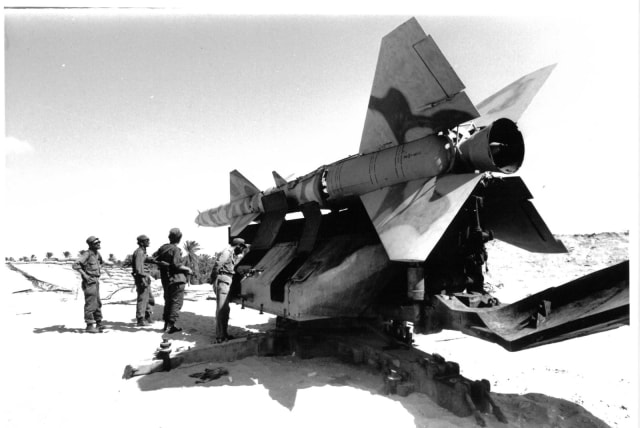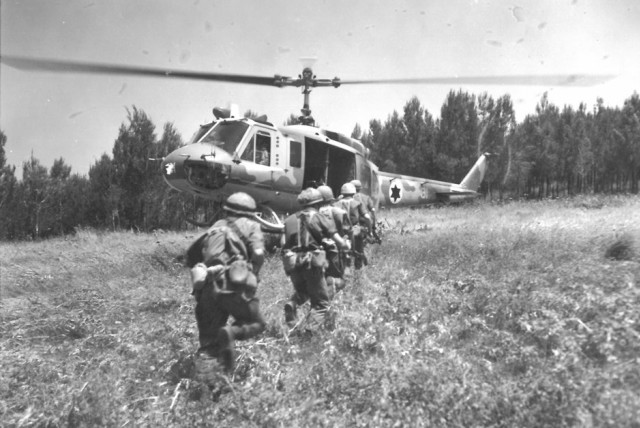'Eighteen days in October': How Israel failed to stop an Arab invasion - review

Israel’s two greatest national traumas were failures of Israeli vigilance and intelligence analysis, abetted by complacency.
Hamas’s deadly penetration of southern Israel occurred 50 years and a day after the near-disastrous attacks of the Yom Kippur War.
Israel’s two greatest national traumas were failures of Israeli vigilance and intelligence analysis, abetted by complacency. The first war heightened resistance to returning the Golan Heights to Syria. The latest has consequences yet unknown.
Israel, in fact, won in 1973 – at great cost – retaining the Golan, surrounding Egypt’s Third Army. and threatening Cairo. But the two countries’ views distort like a fun-house mirror, says Uri Kaufman in Eighteen Days in October, his readable, insightful history of the war.
“Countless nations have fought wars over the millennia; any one of them could have deemed the Yom Kippur War a victory for the ages,” he says. But in Israel, with 2,688 war dead, “victory assumed the shape of defeat.”
Egypt “did everything to ensure that defeat assumed the shape of victory,” Kaufman says. “[President Anwar] Sadat and his wife each wrote in their memoirs that it was the Israeli army that was surrounded, not the Egyptian.”
How Israel won, but lost, the Yom Kippur War
Kaufman wisely begins with the 1967 Six Day War, in which Israel’s preemptive air attacks created quick victory, “but only because everything went perfectly,” he says.
He describes Egypt’s armistice violations, moving Soviet antiaircraft missiles to the canal, which would prove costly to Israel, and shelling during the War of Attrition, which in one 1970 month killed 70 Israeli soldiers.
He outlines various proposals for Egyptian-Israeli peace, with rejections from each side.
The 1967 victory created overconfidence, despite 776 Israeli deaths. Egypt, smarting from humiliation and 18,300 dead, wanted to regain honor, territory, and control of the profitable Suez Canal.
The Yom Kippur attacks were a surprise, but less from lack of intelligence and warning than from faulty analysis and disbelief. Jordan’s king warned Israel on September 25, Kaufman says, but Hussein had issued three false alarms since May. Kaufman quotes IDF intelligence chief Eli Zeira as saying: “I can definitely give notice before any crossing of the canal.”
His reason: “the right-hand man of Anwar Sadat,” Kaufman says. Sadat’s presidential secretary Ashraf Marwan “saw everything that crossed Sadat’s desk,” Kaufman says. Marwan – in Israel’s pay – sent a last-minute warning, but he’d sent two others months earlier for attacks that hadn’t occurred.
And wily Sadat had played a game of crying wolf, holding exercises at the canal and mobilizing reservists 22 times between January 1 and October 1, Kaufman says.
Israel, population just three million, couldn’t call up its mostly reserve army at every feint – both for the expense and for the economic cost of taking massive numbers of workers from their jobs.
IDF intelligence saw the October buildups but could not say whether they meant imminent war. Israel had been warned – practically ordered – against a preemptive strike, by US secretary of state Henry Kissinger. Israel had to be seen as defending itself.
The result was Egypt conquering almost all of the eastern coast of the canal, and Syria nearly overrunning northern Israel – prevented only by Syrian incompetence and a couple of handfuls of greatly outnumbered Israeli tankers holding on, sleepless for three days, moving from place to place and tank to tank to create the illusion of a larger force.
Israel’s canal defenders were in a series of outposts, each with 20 or fewer men, “all from the Jerusalem Brigade, a collection of immigrant soldiers with limited training [who] held out for at least 24 hours, a good deal more than anyone had a right to expect,” Kaufman says.
He describes the two-front war clearly in alternating chapters, with maps showing locations and troop movements. He avoids getting so deep in detail that we lose the big picture. He’s unsparing of Israeli defeats, blunders, and dysfunctional disagreements among generals. And he’s candid about general Ariel Sharon’s independence and disobedience.
Sharon wanted to cross the canal much earlier than did his bosses. The modest force he sent across before approval of a major attack, and his hard work in marshaling the major crossing, made a hero of a general several times nearly fired.
New Yorker Kaufman, a lawyer and adaptive restorer of historic buildings, worked on Eighteen Days for two decades, visiting battlefields, interviewing participants – including a former Syrian officer – and reviewing thousands of pages. The book has 41 pages of tiny-type notes and an index. Research was aided by several Israelis and the 2,000-page report of the Agranat Commission, which investigated the war and affixed blame – sometimes inappropriately, Kaufman says.
His descriptions of Kissinger are unflattering, and he highly praises Israel’s much-blamed chief of staff David Elazar. A bonus is the description of the demands and threats of the USSR, the US responses, and the negotiations leading to an Israeli-Egyptian armistice; there is none with Syria.
He says that prime minister Golda Meir, whose reputation suffered, should be remembered instead as one of Israel’s great premiers, creating the appearance of calm – despite once contemplating suicide – and remaining resolute against pressure to accept unfavorable armistice terms.
“Golda had pulled off the impossible,” Kaufman says. “A lioness in orthopedic shoes...stared down the Soviets, steamrolled the Egyptians, and outlasted the Americans. On the battlefield of international diplomacy, outnumbered by men in fine tailored suits, she fought each and every one to the point of exhaustion.
“For in the end, what dictated the outcome...was the same thing that dictated the outcome on all the smoking battlefields of the Yom Kippur War.
“Golda Meir held out one minute longer.” ■
- Eighteen Days in October: The Yom Kippur War and How It Created the Modern Middle East
- Uri Kaufman
- St. Martin’s, 2023 | 386 pages; $32
Neal Gendler is a Minneapolis writer and editor.
Jerusalem Post Store
`; document.getElementById("linkPremium").innerHTML = cont; var divWithLink = document.getElementById("premium-link"); if (divWithLink !== null && divWithLink !== 'undefined') { divWithLink.style.border = "solid 1px #cb0f3e"; divWithLink.style.textAlign = "center"; divWithLink.style.marginBottom = "15px"; divWithLink.style.marginTop = "15px"; divWithLink.style.width = "100%"; divWithLink.style.backgroundColor = "#122952"; divWithLink.style.color = "#ffffff"; divWithLink.style.lineHeight = "1.5"; } } (function (v, i) { });

